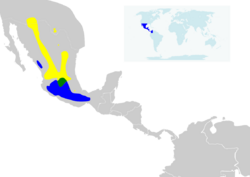Biology:Lucifer sheartail
| Lucifer sheartail | |
|---|---|

| |
| Male lucifer sheartail | |
| Scientific classification | |
| Domain: | Eukaryota |
| Kingdom: | Animalia |
| Phylum: | Chordata |
| Class: | Aves |
| Clade: | Strisores |
| Order: | Apodiformes |
| Family: | Trochilidae |
| Genus: | Calothorax |
| Species: | C. lucifer
|
| Binomial name | |
| Calothorax lucifer (Swainson, 1827)
| |

| |
breeding range Non-breeding range
| |
The lucifer sheartail or lucifer hummingbird (Calothorax lucifer) is a medium-sized, 10 cm long, green hummingbird with a slightly curved bill and distinctive outward flare of its gorget feathers. Its habitat is in high-altitude areas of northern Mexico and southwestern United States. It winters in central Mexico.
Description
The lucifer sheartail is a medium-sized, 10-centimetre (3.9 in) long, green hummingbird with a long curved bill, small wings, and white streak behind its eye.[3] The male has an iridescent plumage, forked dark tail, green crown, long magenta gorget, and white underparts.[3][4] The female is larger with duller plumage, pale throat and white or buff feathers underside, usually with crimson trim.[3][4]
Distribution
The lucifer sheartail is distributed to deserts and arid areas with agave plants in the southwestern United States, from southwest Texas , extreme southwestern New Mexico to southeastern Arizona, and in central and northern Mexico.[3] It is also found in the Madrean sky islands of the northern end of the Sierra Madre Occidental, Mexico.[citation needed] Its preferred habitat tends to be at altitudes of 3,500–5,500 feet (1,100–1,700 m) in canyons, mountain slopes, and dry washes having desert shrubs and cacti.[3] In winter, the birds migrate to central Mexico.[3]
Diet
The diet consists mainly of nectar from agave and colorful desert flowers, spiders and small insects.[3] Lucifer sheartails have a typical hummingbird flight style while feeding from flowers, catching insects in flight, and flying in straight lines to specific destinations for other food, the nest or for roosting.[3] Males defend feeding areas from males, other females, and black-chinned hummingbirds.[3]
Breeding and behavior
During courtship, males attract females by hovering high above the female, then dive with the wings or tail making a snap sound, then flying away with the tail feathers forked and making a different series of snapping sounds.[3] The display lasts 30 to 45 seconds and may repeat several times an hour.[3]
Females build nests on desert shrubs or cacti on steep, dry, rocky slopes, typically 2–10 feet (0.61–3.05 m) above ground, sometimes on top of a previous nest.[3]
The female lays two white eggs in the small cup-like nest, having one or two broods per season.[3] The egg incubation duration is about 15 days, and the chicks nest for about 23 days.[3]
Status
A locally common species in its range, the lucifer sheartail is evaluated as stable and Least Concern on the IUCN Red List of Threatened Species.[1][5]
Gallery
References
- ↑ 1.0 1.1 BirdLife International (2016). "Calothorax lucifer". IUCN Red List of Threatened Species 2016: e.T22688185A93185872. doi:10.2305/IUCN.UK.2016-3.RLTS.T22688185A93185872.en. https://www.iucnredlist.org/species/22688185/93185872. Retrieved 12 November 2021.
- ↑ "Appendices | CITES". https://cites.org/eng/app/appendices.php.
- ↑ 3.00 3.01 3.02 3.03 3.04 3.05 3.06 3.07 3.08 3.09 3.10 3.11 3.12 3.13 "Lucifer hummingbird overview". www.allaboutbirds.org. All About Birds, Cornell University Laboratory of Ornithology. 2019. https://www.allaboutbirds.org/guide/Lucifer_Hummingbird/overview.
- ↑ 4.0 4.1 "Lucifer hummingbird". Visual resources for ornithology, The Academy of Natural Sciences of Drexel University. 2015. http://vireo.acnatsci.org/search.html?Form=Search&SEARCHBY=Common&KEYWORDS=lucifer+hummingbird&showwhat=images&AGE=All&SEX=All&ACT=All&Search=Search&VIEW=All&ORIENTATION=All&RESULTS=2.
- ↑ "Lucifer hummingbird, Calothorax lucifer". 2020. http://datazone.birdlife.org/species/factsheet/lucifer-hummingbird-calothorax-lucifer.
External links
Wikidata ☰ Q522173 entry
 |






